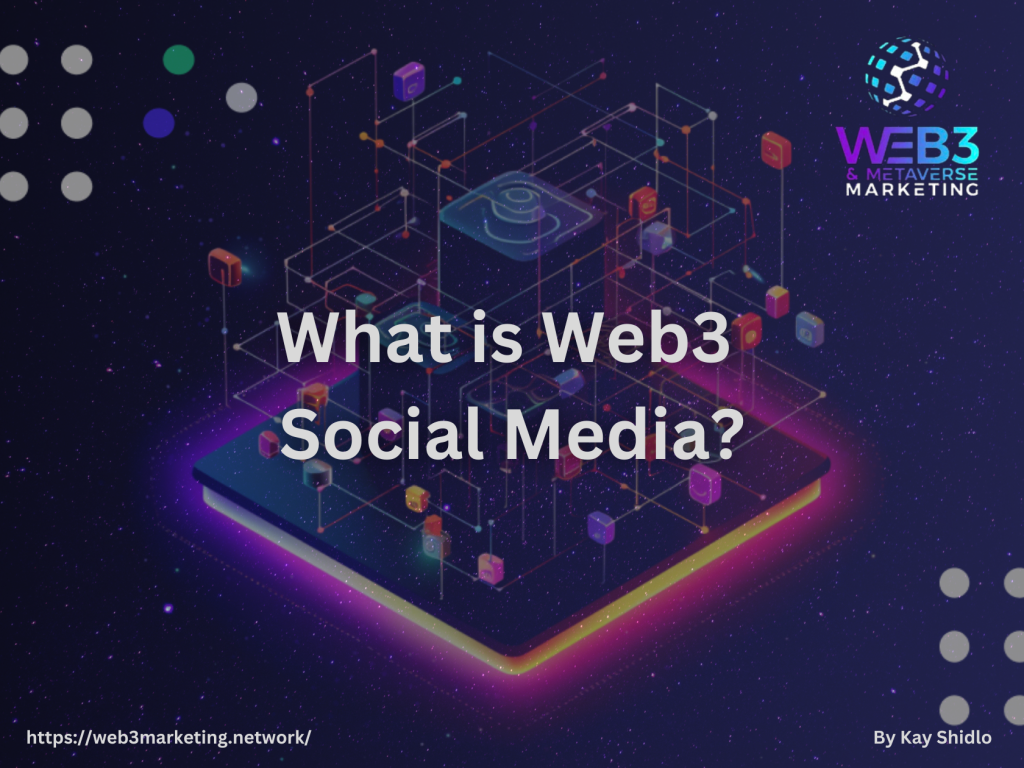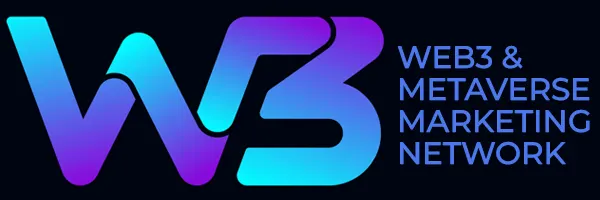By Urooj Ashraf

Web3 social media channels are applications that leverage decentralized technologies consisting of cryptocurrencies, smart contracts, and blockchain networks.
The main purpose of decentralized technologies is to provide an experience centered on user control, security, and privacy.
Web3 in Social Media aims to build a decentralized social media ecosystem shifting from the
traditional Web 2.0 social media. These platforms run on blockchain technology with no
ownership of a single entity, making them less susceptible to centralized control or censorship.
Users have more control over the ownership of their data and online identities and often
contribute to having a say in platform development. The tokenized economies ensure that
platforms have built-in cryptocurrencies (tokens) to reward creators, enable direct payments and
encourage participation.
Why Marketers Should Care
Web3 social media gives unlimited access to new audiences attracting crypto-savvy users who
are passionate about technology, decentralization and potentially open to new brands and ideas.
Users have more control over their data meaning increased transparency and potential to forge
more authentic connections.
Similarly token economies enable direct interaction with the customers bypassing the traditional
intermediaries. Web3 social media offers innovative features to engage such as NFTs, gamified
experiences and community governance. Early adoption also demonstrates tech-forward
branding and a willingness to experiment.
Practical Marketing Considerations
- Understanding Crypto & Communities: Marketers need a basic grasp of cryptocurrencies, wallets, and the unique culture of Web3 communities.
- Audience Focus: Target specific Web3 platforms based on their demographics and themes (some are music-focused, others are more general, etc.).
- Authenticity is Key: Web3 communities value transparency and genuine participation. Avoid overly promotional approaches.
- Token & NFT Integrations: Consider how your brand offerings might work within a tokenized economy, or how NFTs could be used for exclusive access, rewards programs, etc.
- Measurement & KPIs: Web3 analytics are evolving. Define what success looks like (token price, on-chain engagement, etc.)
Should Every Marketer Dive In?
‘Experimentation is the key’ since Web3 social media is constantly developing. It’s most
appealing for marketers who are open to long-term community building not small time
campaigns, marketers who want to explore innovative customer engagement models and those
who want to work with tech-savvy brands.
Conventional social media apps like X, Instagram, Facebook and Linkedin run on centralized
servers, Web3 platforms operate on blockchain networks like BNB Smart Chain or Ethereum.
These platforms are decentralized and remove the issues associated with single points of
central control, and censorship. All Web3 Social Media Platforms are websites and apps that
use blockchain networks, smart contracts, and other decentralized technologies to enhance
security and privacy while giving users more control.
Benefits of Web3 Social Media Platforms
Web3 social media apps have many benefits compared to the conventional platforms:
- Ownership and User Privacy: Users typically have complete ownership over theirpersonal information, interactions and, content. This significantly reduces the risk ofdata exploitations and manipulation.
- Interoperability: The Web3 social media ecosystem aims to break down barriers between various dApps, allowing users to seamlessly interact and share content across multiple platforms.
- Decentralized Governance: Web3 social media platforms implement a decentralized governance model, empowering users to participate actively in shaping the platform’s policies. Conventional social media applications are generally controlled by a centralized authority, giving rise to concerns related to censorship.
- Tokenized Economy: Web3 social media platforms leverage cryptocurrencies to incentivize engagement, curation, and content creation. This allows users to earn tokens for their contributions, encouraging a more democratic ecosystem.
There are many prominent Web3 social media platforms on the market, and we won’t be able
to cover them all in this guide. Therefore, in the following subsections, we’ll explore a list of
five popular and industry-leading Web3 social media platforms.
1. Farcaster
Farcaster is a decentralized social media protocol built with a focus on privacy, user autonomy,
and interoperability. Leveraging blockchain technology, Farcaster aims to solve the previous
issues of privacy breaches, censorship, and centralization that plague traditional social media
platforms.
Farcaster is an open protocol that supports many clients, users can openly migrate social
identities between applications and developers can freely build applications with new features on
the network. With Farcaster, you can send short text message broadcasts that connect to your
Ethereum address. Verifying address ownership also enables a range of features which includes
showcasing your NFT and using your NFT as a verified avatar and more.
What sets Farcaster apart in the crowded space of dApps?
- Smart Contracts for Social Interactions: Farcaster uses smart contracts to govern the interactions within the network, from engagements to posting content. This allows certain processes by introducing a layer of customization and programmability to social networking.
- Interoperability: Among Farcaster’s standout features is the focus on interoperability. It is designed to seamlessly interact with other blockchain networks which enables the valued fluid exchange of assets and information across different platforms. This results in multiple social media dApps being built through Farcaster protocols such as Warpcast.
- Blockchain Basis: Farcaster runs on the robust optimism blockchain infrastructure, ensuring decentralization, security, and transparency. Farcaster doesn’t rely on central servers minimizing the risks of censorship and data breaches.
Farcaster’s built-in feature includes more social platforms, user-controlled and privacy-centric.
Initiated by a team of blockchain developers and experts to redefine social media, Facaster’s
journey from concept to development targets the interest in decentralized digital communities.
Farcaster was kickstarted by Elon Musk’s acquisition of social media platform Twitter in 2022.
Unique Selling Propositions (USPs):
- Minimizing Bot activity: Farcaster requires that sign-up users pay a $5 fee aimed at preventing
the creation of spam accounts while limiting the users to restricted no of casts tied to paid storage
units. - Economic Models: Farcaster also introduced innovative economic models, hence allowing users
to monetize their content through tokenization and cryptocurrency. This fosters a new ecosystem
of value exchange. - Censorship Resistance: Farcaster provides a platform where free speech is less susceptible to
censorship by any of single entity by decentralizing the control over the content. - Privacy and security: Farcaster gives importance to security and privacy ensuring users have
full control over their data and offering encrypted communication.
Current Development Stage
As of March 2024, Farcaster is in an active development phase which focuses on the expansion
of its features, building a stronger community, and enhancing user experience. The team is
actively engaging with developers and users to gather feedback, ensure scalability and refine
functionalities. Some of the key milestones consist of:
- Integrations and Partnerships: Strategic partnerships with the other platform and blockchain
projects are in progress aimed at expanding the network’s reach and enhancing interoperability. - Community Growth: Farcaster community is growing actively with efforts including improving
developer tools, and forums to support collaboration and documentation. - Beta Releases: The ongoing beta releases allow early adopters and test and contribute to the
evolution of Farcaster offering a glimpse into the Farcaster’s capabilities.
Farcaster aims to offer an alternative to centralized social media platforms as one of the best-
performing decentralized social networking projects as compared to twitter and Mastodon etc.
Launched in January 2024, Farcaster’s Frames feature enables users to perform functions within
Farcaster apps, without exiting to a third-party application.
2. Diamond
A social media platform is built on a blockchain and emphasizes supporting content creators,
Diamond App has been launched on DeSo( the Decentralized Social Blockchain) which raised
$200 million from Andreessen Horowitz, Sequoia, and Coinbase. DeSo is the only blockchain
that enables all social graph data, posts, and content to be stored on-chain enabling transparency
and openness in social media. Its architecture is similar to Bitcoin with the addition of supporting
complex social network data at a larger scale. Diamond app social network app combines social
media with investments and it’s built from the ground as its own custom blockchain.
Apps are being built on DeSo where blockchain technology enables more transparency,
openness, and monetization opportunities for creators. Diamond app is experiencing major
growth in the wake of the turbulence at Twitter. Creators are excited to post on Diamond since
it’s giving them more control and ownership over their data. Diamond appeals to founders,builders, creators, and casual social media users. Additionally, it has blogging functionality and
several money-native features creators can use to build, scale and monetize their audience.
Diamond’s integration of the DeSo wallet makes it possible to onboard Ethereum. The DeSo
wallet supports both a one-click MetaMask login and one-click Google login.
Diamonds
Diamonds are tips that users can give each other for posts. Each diamond you
receive is worth real money.
So, if you like the post then you can tip in the form of diamonds and it will transfer from your wallet to theirs. This is a way to support your favorite creators and some value to their content at the same time.
As soon as you set up a profile on Diamond, you have a creator coin. This becomes a social
token that can be purchased by all the users which ensures effective investing in the best
creators. This leads to not only the support of favorite creators financially but also helps them
with the growth of their audience. The team behind Diamond is focusing on building an engaged
community around the platform. They offer bounties for users who complete challenges or
certain tasks.
Every post you make can be turned into an NFT and the NFTs you purchase will show in your
profile for all your followers. Some examples of Social NFTs are collectible ticket stubs,
physical memorabilia, exclusive experiences, exclusive unlockable digital content, exclusive chat
groups, and many more. Blogging on Diamond is decentralized and permission less. All content
is 100% open source and on-chain.
NFTs
With Diamond, you can mint NFTs with a simple click. This makes it easy to create and
share digital collectibles with your followers. Plus, the NFTs you create will be secure as they
are stored on the DeSo Blockchain.
3. Minds
Minds is decentralized and open-source social networking platform where users are rewarded
with Minds tokens for contributions to the community. The Minds token is an open-source social
networking utility built upon the Ethereum standard.
Minds is one of the largest networks in the decentralized social media space and has generated around a billion views. During this era, the Minds app offer the solution of open dialogue and freedom of speech. The crypto network and blogging platform has 200k+ monthly active users with 1.25 million registered users.
Minds is an open-source and decentralized alternative to X focusing on user empowerment, free
speech, and privacy. The platform provides an encrypted and decentralized network where the
users control their data and can earn rewards in the form of the platform’s native ERC-20
MINDS token in return for publishing content.
This token shows appreciation for other users, allows users to promote content, and a lot of utility leads to upgrade to a premium membership with Minds!
Minds is also a decentralized alternative to X where users can earn crypto tokens in return for
publishing engaging content! Open-source Web3 social media platform prioritizes user privacy,
users earn Minds tokens for supporting and boosting content.
Similarly, integration with the Ethereum blockchain ensures transparency for the token transactions. Minds is using blockchain technology to enhance the benefits and experience for the community to give privacy back to the people. Minds rewards you with Minds tokens every day for providing liquidity, referring friends, and creating popular content. The tokens can be used to promote your content to content creators to unlock some special perks and show your support.
Minds is marketed as the leading alternative social network on its homepage. It also insists
heavily on monetization as it allows people to send you direct payments through Ether, Bitcoin,
and USD. Those who earn the tokens for their content can use them for many things such as
boosting your content or upgrading your channel. They have a code of conduct that states that
the code base is open-sourced for anyone to look at it in their free-speech social network. They
have a code of conduct that states that the code base is open-sourced for anyone to look at it or to
even fork out into their free-speech social network if they so wished.
4. Mastodon
Mastodon is a user-friendly microblogging platform also known as upgraded version of Twitter.
Mastodon is a Web3 alternative of Twitter, consists of a global network of communities that are
not run by a centralized authority. Mastodon was created since 2016, but it experienced rapid
growth since many users preferred using decentralized Mastodon instead of Twitter.
Mastodon is ad-free, free to use and developed by a nonprofit organization. It is run by creator
Eugen Rochko which was a popular crowdfunding campaign. Mastodon social network is made
up of independent servers organized with specific interests, topics, and themes. People can
follow each other, join servers, engage in conversations, etc.
Users have associated Mastodon as an app that makes it easier to build a community, have
friendly and open discussions without pile-on, and the autonomy it gives server members and
hosts. User autonomy is also linked to the decentralized nature of the Mastodon. This means that
users are not beholden to the whim of a platform and its owners. They can decide what they are
comfortable with. Another major benefit of Mastodon is that user data is not controlled by any
major organization.
Fediverse
Mastodon is a great example of how you can have a great social media platform while avoiding
the negative effects of corporate social media such as centralized control, selling user data, and
monitoring user activity. Mastodon is known as the ‘federated’ network which is a collection of thousands of social networks run on servers across the world that are linked by the common
Mastodon technology. This platform is known as the Fediverse.
How does Mastodon work?
The major difference between Twitter and Mastodon can be summed up in a single word:
decentralization. While people are working at the non-profit Mastodon, the platform itself isn’t
centralized within that company. The reason is because it is made up of thousands of
independent servers. Consider Mastodon server as a forum or a mini social network. Normally a
server is organized around a specific industry, topic, or interest. Once a user joined a server, any
user can follow, engage, or reply to anyone on Mastodon.
What do users usually do on Mastodon?
They can talk about what’s on their mind, contribute to the conversations and trends, and do other social media-related tasks. For everything, you will also need to pick a server to host your account. Use mastodonservers.net to find the server as you require.
Businesses who want to avail the services of Mastodon, can’t go through a single person or
platform to do so since it’s a network of servers. Mastodon’s policies state that service will never
serve ads or promote some profiles of users over others. There is no profit incentive and neither a
desire to work with the advertisers. However, there are still other ways for businesses to take
advantage of the platform. With Mastodon you cannot search topics via hashtags due to the
different algorithms. Every server is a self-contained community that is gathered around a single
topic regarding a specific career, a shared interest, etc. Therefore, businesses need to find the
right server where you can get unfiltered access to all that matters for your market segment and
target demographic.
Businesses can also run affiliate marketing and sponsorship through Mastodon. You could also
try reaching out to individual users to find the right marketing segment. Currently the follower
counts on Mastodon are much lower as compared to Twitter. For example, George Takei has
only 235,000 followers on Mastodon and 3.4 million followers on Twitter.
Another way to advertise is to target independent servers. Since each server operates
independently, any server owner can allow their infrastructure to accept the payments.
Currently, Mastodon has more than 8000 servers. This is an opportunity for any user to become
an expert in an underserved topic. You can create your server, pick a topic that fits your niche,
and start with content. Therefore it has become a favorite app for many.
5. Steemit
Steem is a Web3 social media blockchain that grows on the communities and makes direct
revenue streams possible for users by rewarding them for sharing the content that brings the
specific qualities of the blockchain to the online social networking domain.
Steem empowers the online community to earn value and become shareholders for publishing and creating content over Steem-based apps. It is currently the only blockchain that can power real applications via social apps like Steemit. Steemit is another web3 platform flipping the switch from the model of conventional social networks to a free, fast, and scalable blockchain-based solution.
Steem was created by Dan Larimer and Ned Scott. Larimer is a software engineer who also
created Bitshares in the past. Steem has fast transaction rates, almost every 3 seconds and its
smart bandwidth technology gives users the benefit of free transactions. Steem’s blockchain is
designed to support large-scale social applications. The more people register themselves on
Steem, the greater the value of Steem dollars. The current price of STEEM is $0.35 with a 24-
hour trading volume of $9.7 million since 30 th March 2022. The total market cap of STEEM is
$140.25 million.
Steem also incorporates a rewards system to create incentives for the users to create and engage
with the content on the platform. Since users create content, many users might get attracted to the
platform while the existing users remain engaged. Users who upvote posts on Steemit also help
in distributing the coins to those who provide value to the network. Steemit rewards both
whether they vote and post according to their worth. However, the weighting mechanism that
was used to value the people’s votes has been scrutinized.
What Apps and Projects Run On Steemit?
At the time of writing, Steemit has over 300 dApps that run on the Steem blockchain. The three
most popular apps include:
- Steemit
Steemit is a social media platform built on the Steem blockchain. While not explicitly part of the
DeFi movement and ecosystem, Steemit’s focus on community-posted rewards, and automated
curation make it one of the most promising social media apps in crypto. - Utopian
For those who want to get into blockchain development, Utopian is an open-source project that
lets users earn their way up the ladder by contributing code. However, it doesn’t provide a space
where users post their own content, but rather focuses on rewarding contributions to the project
in many ways. This may include bug fixes, general development, new features, etc. - Dtube
Dtube is a decentralized video hosting platform that uses the STEEM blockchain as its base. As
with all blockchain projects, there are several benefits when using Dtube compared to traditional
sites like Youtube.
How Does Steemit Work?
Steemit is a social media platform that combines the best parts of Reddit and Medium. However,
unlike Reddit, Steemit pays its users in crypto for their posts rather than using ads or other
monetization methods.
Steemit is built on the Steem blockchain—a decentralized, peer-to-peer network where users
earn cryptocurrency for their posts. The platform uses a Proof-of-Brain algorithm to reward users
for their contributions.
The Steemit community is made up of three main groups: content creators (users who post
original written or visual material), curators (users who upvote posts), and witnesses (users who
secure the network).
- Content creators get paid in STEEM tokens, which can be exchanged for Bitcoin or other cryptocurrencies on external exchanges.
- Curators also receive some STEEM tokens for their efforts, but they do not have voting rights on the platform.
- Witnesses are responsible for ensuring that all transactions are valid and secure; they are also paid in STEEM tokens.
How Can You Make Money With Steemit?
Steemit users are rewarded with Steem cryptocurrency for posting content that other users
upvote such as articles, photos, videos, and more. They can also gain more Steem by becoming
an active member of the community (by voting on other people’s posts and leaving thoughtful
comments), which increases their influence score.
When you post something on Steemit, you earn “Steem Power” which increases your influence
on the site and allows you to earn more money from your posts. You can also earn “Steem
Dollars” which can be traded for US dollars or other cryptocurrencies.
The more influence you have, the higher your earnings can be. However, there are no ads or paid
subscriptions; instead, all content is entirely user-generated.
Understanding Steem Crypto
The Steem network has two different tokens:
- Steem Dollars (SBD)
- Steem (STEEM)
Users can be rewarded in both tokens. The default setting is to receive 50% of rewards in SBD
and 50% in Steem. Users have been given the flexibility to alter this ratio. Steem crypto can be
powered up into the STEEM power. Steem power gives users more sway over the voting
mechanism which further powers Steemit and increases their potential rewards. While SBD and
STEEM coin are cryptocurrencies that can be traded off-platform, STEEM Power can only exist
on Steemit.
Steem Dollars are used to reward those who comment, post or upvote posts on the Steemit. Users
can also receive rewards in STEEM tokens. Those who want to quickly power up should choose
more STEEM rewards. If users are looking to cash out their rewards might want more STEEM
Dollars. SBD can also be converted into the STEEM. STEEM power has more influential votes
which means when they upvote anything, the user gets a greater reward. Those posts that are
judged to be most valuable by the community will become well-rewarded.
Steemit has a few advantages over the rest of the social media networks which include coping
with censorship, rewarding users, and reaching an audience beyond the world of crypto. Steemit
is based on immutable blockchain which makes it much harder for any central authority to
censor the content of people. Users who are shadow-banned will find this interesting. Similarly,
users will be rewarded for their role in the participation of the Steemit economy. Since Steem
dollars can be exchanged for currencies like Bitcoin, many users prefer Steemit.











